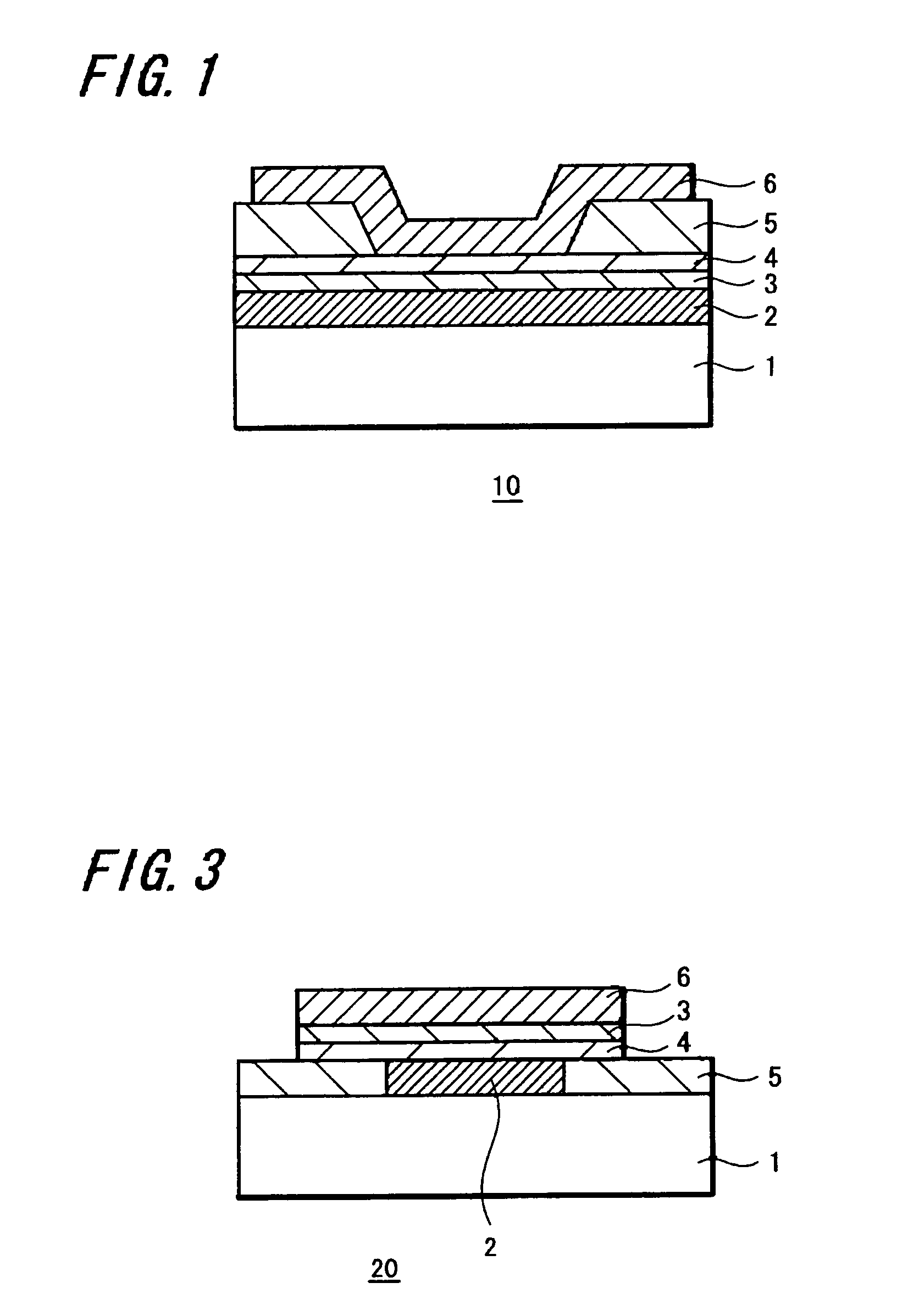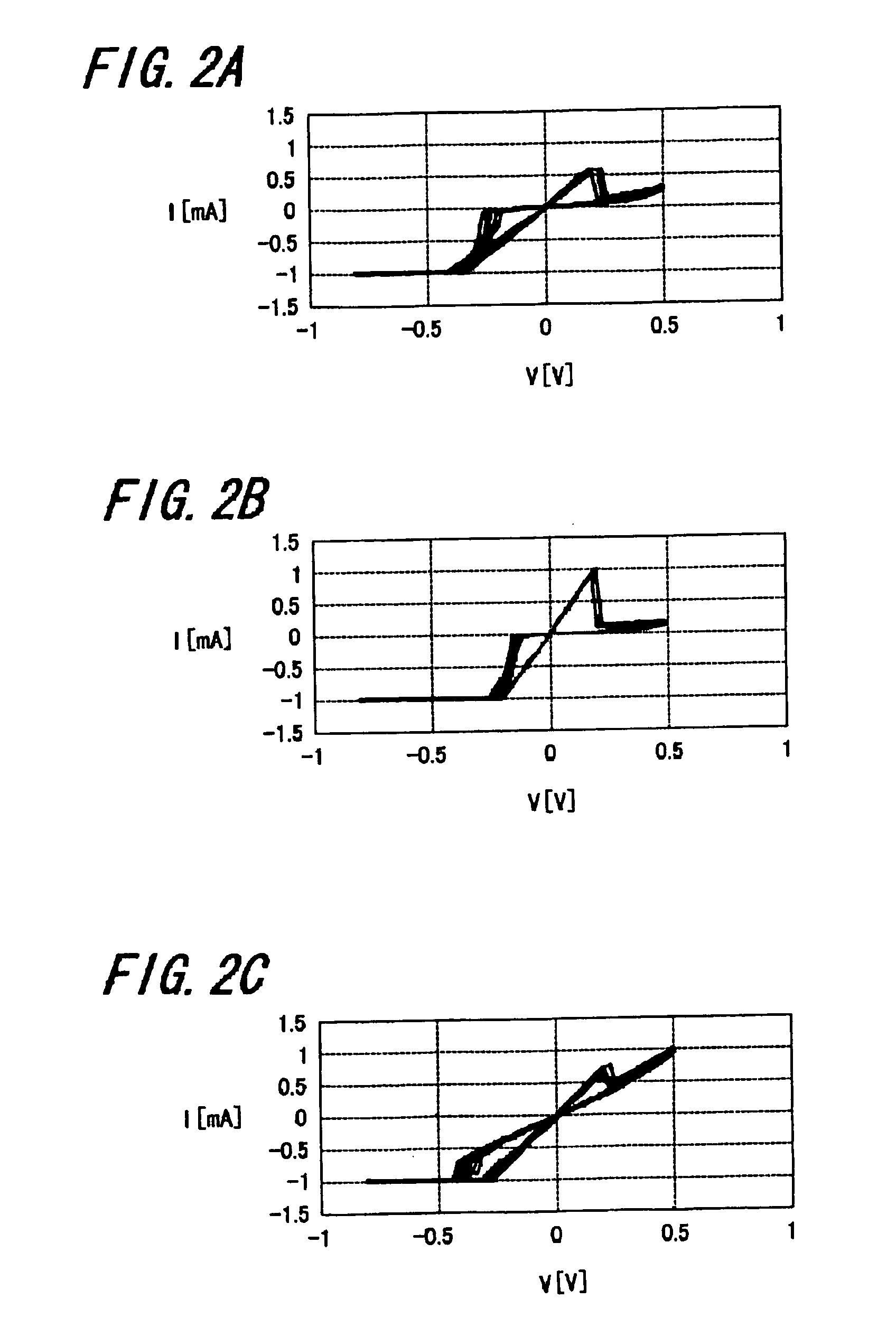Memory element and memory device
a memory element and memory technology, applied in the field of memory elements, can solve the problems of inability to obtain high speed operation of memory elements, and achieve the effects of preventing further deterioration of memory elements, enhancing reliability of memory elements, and maintaining stably
- Summary
- Abstract
- Description
- Claims
- Application Information
AI Technical Summary
Benefits of technology
Problems solved by technology
Method used
Image
Examples
experiment 1
[Experiment 1]
[0123]On a silicon wafer, a tantalum (Ta) film of 20 nm in thickness was deposited as the lower electrode 2, a Cu50Te35Ge15 film of 20 nm in thickness was formed thereon as the ion source layer 3, an oxide tantalum film was formed as the memory thin film 4 and photoresist was formed to cover the surface, and after that, exposure and development were performed by means of photolithography to form an opening (through hole) in the photoresist on the memory thin film 4. Among those layers, the oxide tantalum film was formed such that after a tantalum film in the metal state was formed in the thickness of 1 nm by sputtering, oxidation treatment was performed in oxygen contained plasma atmosphere. It is assumed that the oxide tantalum film became somewhat thicker than the original tantalum film by the above oxidation treatment.
[0124]Subsequently, annealing treatment was performed in a vacuum and the photoresist was transformed to be the insulation layer 5 as hard-cured resis...
experiment 2
[Experiment 2]
[0138]Instead of the memory element 10 shown in FIG. 1, a memory element 20 shown in FIG. 3 was manufactured as another embodiment of the present invention and the characteristic thereof was studied.
[0139]In the memory element 20 shown in FIG. 3, the memory thin film (memory layer) 4 was formed below the ion source layer 3, on the contrary to the memory element 10 shown in FIG. 1 according to the previous embodiment. Further, the upper electrode 6 was made of the same pattern as the memory thin film 4 and ion source layer 3. The lower electrode 2 was made of a smaller pattern and was buried in an opening formed in the insulation film 5.
[0140]Similarly to the memory element 10 according to the previous embodiment, since the memory thin film 4 (memory layer) 4 in the memory element 20 shown in FIG. 3 is made of the above-described oxide film, the thermal resistance of the memory thin film (memory layer) 4 is improved, a yield ratio of manufacturing the memory element 20 ...
experiment 3
[Experiment 3]
[Repeated Recording and Erasure Experiments]
[0162]Next, a measuring apparatus was constructed as shown in FIG. 8 with respect to a sample of the memory element 20 similar to the one used in the experiment 2, and the recording and erasure experiments were repeatedly performed.
[0163]The measuring apparatus shown in FIG. 8 includes an arbitrary waveform generator 31 and a digital oscilloscope 32.
[0164]The arbitrary waveform generator 31 was connected to the load resistance enclosed by a broken line through a pulse applying line 33. Further, the digital oscilloscope 32 was connected to the load resistance through two voltage monitor lines 34. The load resistance had two lines of the resistance value 50 Ω and of the resistance value RL (2 kΩ).
[0165]Further, wiring was connected from the load resistance to the substrate of the wafer 35 (rear surface side) and to the upper electrode side, respectively.
[0166]Using the above-described measuring apparatus, a recording process wa...
PUM
 Login to View More
Login to View More Abstract
Description
Claims
Application Information
 Login to View More
Login to View More - R&D
- Intellectual Property
- Life Sciences
- Materials
- Tech Scout
- Unparalleled Data Quality
- Higher Quality Content
- 60% Fewer Hallucinations
Browse by: Latest US Patents, China's latest patents, Technical Efficacy Thesaurus, Application Domain, Technology Topic, Popular Technical Reports.
© 2025 PatSnap. All rights reserved.Legal|Privacy policy|Modern Slavery Act Transparency Statement|Sitemap|About US| Contact US: help@patsnap.com



